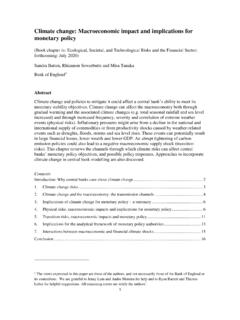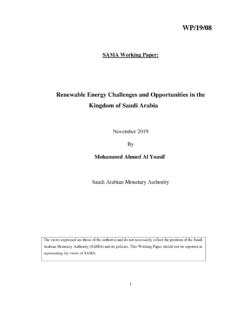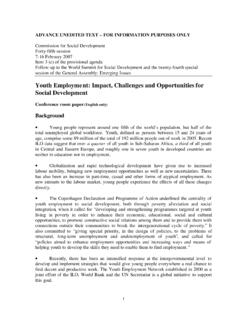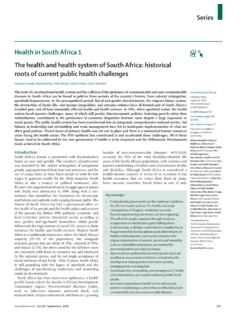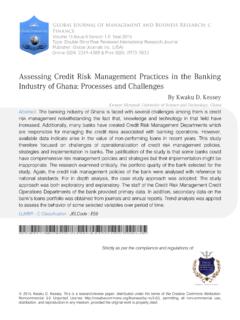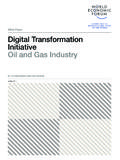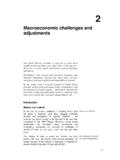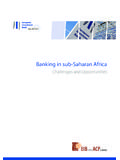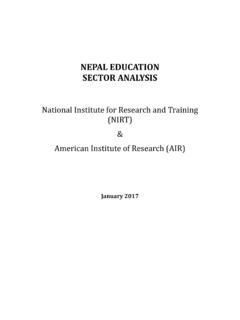Transcription of Stress-testing banks for climate change – a comparison of ...
1 Financial Stability Institute FSI Insights on policy implementation No 34. Stress-testing banks for climate change a comparison of practices By Patrizia Baudino and Jean-Philippe Svoronos July 2021. JEL classification: G18, G21, Q54. Keywords: climate risk, transition risk, physical risk, stress testing, supervisory reviews FSI Insights are written by members of the Financial Stability Institute (FSI) of the Bank for International Settlements (BIS), often in collaboration with staff from supervisory agencies and central banks . The papers aim to contribute to international discussions on a range of contemporary regulatory and supervisory policy issues and implementation challenges faced by financial sector authorities.
2 The views expressed in them are solely those of the authors and do not necessarily reflect those of the BIS or the Basel-based committees. Authorised by the Chair of the FSI, Fernando Restoy. This publication is available on the BIS website ( ). To contact the BIS Media and Public Relations team, please email You can sign up for email alerts at Bank for International Settlements 2021. All rights reserved. Brief excerpts may be reproduced or translated provided the source is stated ISSN 2522-2481 (print). ISBN 978-92-9259-489-3 (print). ISSN 2522-249X (online). ISBN 978-92-9259-490-9 (online).
3 Contents Executive summary .. 1. Section 1 Introduction .. 2. Section 2 Conducting climate change stress tests for banks conceptual issues .. 6. Scenario design .. 6. Data availability .. 7. Modelling blocks and interlinkages .. 7. Granularity of exposures .. 9. Second round effects and management 9. Section 3 climate risk stress tests in practice .. 10. Objectives of a climate risk stress test .. 10. Governance .. 11. Implementation .. 12. Outcomes results and communication .. 21. Section 4 Concluding remarks .. 23. References .. 25. Stress-testing banks for climate risk a comparison of practices iii Stress-testing banks for climate change risk a comparison of practices1.
4 Executive summary Financial sector authorities have become increasingly involved in climate change risks and their impact on the financial sector. Financial authorities, at the global and national levels, are increasingly taking action to require stronger preparedness by the financial industry against climate risk. The authorities' involvement is needed partly because of the growing materiality of climate risks for the financial industry, but also because these risks are expected to materialise over a much longer time horizon than the private sector is used to considering. Enhanced disclosure of exposure to climate change risk, encapsulated in the 2017 report by the Task Force on climate -related Financial Disclosures (TCFD) of the Financial Stability Board (FSB), was a first step in this direction.
5 Since then, growing efforts have been made to quantify banks ' and insurance companies' exposures to climate risks. In this vein, authorities have launched stress tests for banks , and more exercises are planned for the near future. Considering that traditional risk management approaches are unsuitable for measuring climate change -related risks, authorities and the industry have turned to stress tests to try to assess the extent of firms' vulnerability to climate change . Such exercises have been completed in the Netherlands and France, and numerous others are underway, for instance in the Banking Union in Europe, the United Kingdom, Australia, Singapore and Canada.
6 Stress tests are seen as useful tools because of their forward-looking nature and their flexibility. In particular, they can be adapted to capture additional risk drivers such as those related to climate changes. Adapting traditional stress tests to climate -related risks for banks raises challenges , as discussed in the paper. Traditional stress tests were designed to study the impact of external shocks on the solvency of banks . Assessing climate -related impacts requires some fundamental changes. For instance, the risks are expected to materialise over much longer time horizons than those used in respect of traditional banking sector risks.
7 In addition, data covering future climate patterns may be unavailable or unreliable, given the changes in climate patterns that are underway. Moreover, measuring the impact of climate risk requires granular exposure data, ideally by sector and region, in order to differentiate and assess risks along these dimensions. However, these data may not currently be available. In addition, modelling techniques need to be adapted in order to support an exercise that, at a minimum, needs to be composed of four parts. One part refers to modelling the climate variables, the second is to measure the impact of climate on macroeconomic variables, the third is to break down the overall macroeconomic impact across sectors and the fourth one is to quantify the combined impact on financial firms.
8 Notwithstanding these challenges , three pilot exercises reviewed in the paper offer valuable lessons. The paper shows how the technical challenges of a climate risk stress test have been addressed in pilot exercises conducted by the Dutch and French authorities in 2018 and 2021 respectively, and in the exercise currently underway in the United Kingdom. These pilots are seen as highly relevant by the authorities and the industry. They are viewed as a starting point for managing climate -related risks and as particularly useful in beginning to identify and assess an increasingly important source of risk.
9 They can also act as a catalyst to further develop modelling techniques that would be better suited to capturing climate risk and to the collection of relevant data. However, at this stage the stress tests are considered to 1. Patrizia Baudino and Jean-Philippe Svoronos Bank for International Settlements (BIS). The authors are grateful to Laurent Clerc, James Edmonds, Chris Faint, David-Jan Jansen, Edo Schets, Greg Sutton and Jeffery Yong for helpful comments. Dung Tran provided valuable administrative support. The views expressed in the paper are those of the authors and not necessarily those of the BIS or Basel-based standard setters.
10 Stress-testing banks for climate change risk a comparison of practices 1. be exploratory and preliminary, and it is clearly acknowledged that much remains to be improved. Authorities mainly seek to acquire knowledge, help to build capability in financial firms, gather information and assess banks ' strategic outlook. An open issue for all authorities is the nature of their follow-up with the industry, although for now climate stress tests are not expected to trigger new capital requirements. Bank stress tests have traditionally been associated with setting a minimum level of capital for each bank and requirements for remedial action when the hurdle rate is not met.










